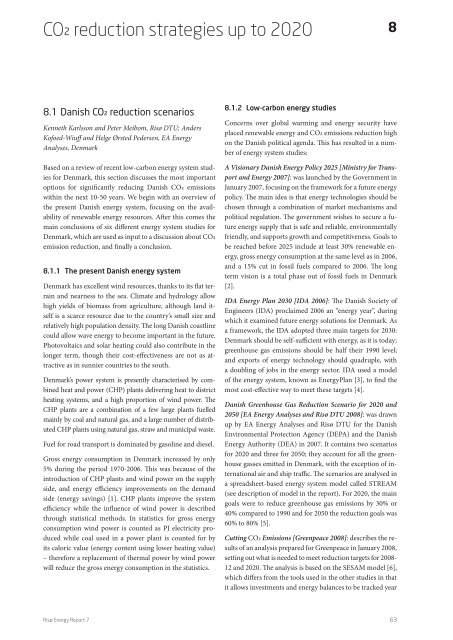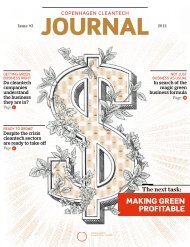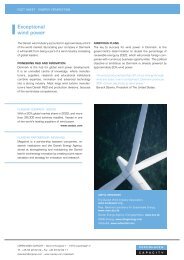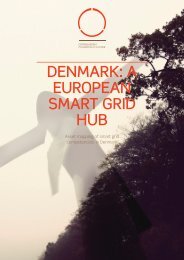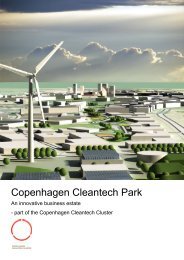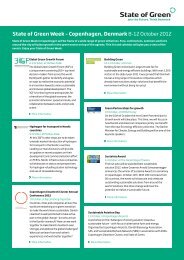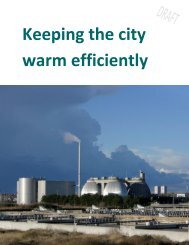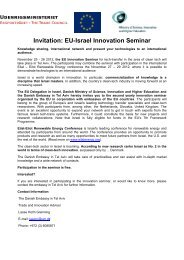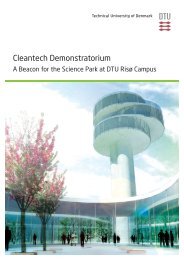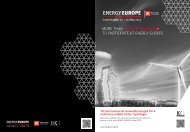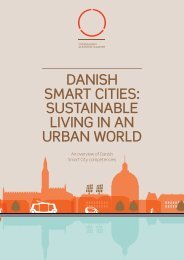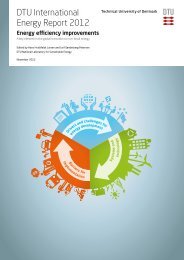Future low carbon energy systems - Copenhagen Cleantech Cluster
Future low carbon energy systems - Copenhagen Cleantech Cluster
Future low carbon energy systems - Copenhagen Cleantech Cluster
Create successful ePaper yourself
Turn your PDF publications into a flip-book with our unique Google optimized e-Paper software.
CO ² reduction strategies up to 202088.1 Danish CO ² reduction scenariosKenneth Karlsson and Peter Meibom, Risø DTU; AndersKofoed-Wiuff and Helge Ørsted Pedersen, EA EnergyAnalyses, DenmarkBased on a review of recent <strong>low</strong>-<strong>carbon</strong> <strong>energy</strong> system studiesfor Denmark, this section discusses the most importantoptions for significantly reducing Danish CO2 emissionswithin the next 10-50 years. We begin with an overview ofthe present Danish <strong>energy</strong> system, focusing on the availabilityof renewable <strong>energy</strong> resources. After this comes themain conclusions of six different <strong>energy</strong> system studies forDenmark, which are used as input to a discussion about CO2emission reduction, and finally a conclusion.8.1.1 The present Danish <strong>energy</strong> systemDenmark has excellent wind resources, thanks to its flat terrainand nearness to the sea. Climate and hydrology al<strong>low</strong>high yields of biomass from agriculture, although land itselfis a scarce resource due to the country’s small size andrelatively high population density. The long Danish coastlinecould al<strong>low</strong> wave <strong>energy</strong> to become important in the future.Photovoltaics and solar heating could also contribute in thelonger term, though their cost-effectiveness are not as attractiveas in sunnier countries to the south.Denmark’s power system is presently characterised by combinedheat and power (CHP) plants delivering heat to districtheating <strong>systems</strong>, and a high proportion of wind power. TheCHP plants are a combination of a few large plants fuelledmainly by coal and natural gas, and a large number of distributedCHP plants using natural gas, straw and municipal waste.Fuel for road transport is dominated by gasoline and diesel.Gross <strong>energy</strong> consumption in Denmark increased by only5% during the period 1970-2006. This was because of theintroduction of CHP plants and wind power on the supplyside, and <strong>energy</strong> efficiency improvements on the demandside (<strong>energy</strong> savings) [1]. CHP plants improve the systemefficiency while the influence of wind power is describedthrough statistical methods. In statistics for gross <strong>energy</strong>consumption wind power is counted as PJ electricity producedwhile coal used in a power plant is counted for byits caloric value (<strong>energy</strong> content using <strong>low</strong>er heating value)– therefore a replacement of thermal power by wind powerwill reduce the gross <strong>energy</strong> consumption in the statistics.8.1.2 Low-<strong>carbon</strong> <strong>energy</strong> studiesConcerns over global warming and <strong>energy</strong> security haveplaced renewable <strong>energy</strong> and CO2 emissions reduction highon the Danish political agenda. This has resulted in a numberof <strong>energy</strong> system studies:A Visionary Danish Energy Policy 2025 [Ministry for Transportand Energy 2007]: was launched by the Government inJanuary 2007, focusing on the framework for a future <strong>energy</strong>policy. The main idea is that <strong>energy</strong> technologies should bechosen through a combination of market mechanisms andpolitical regulation. The government wishes to secure a future<strong>energy</strong> supply that is safe and reliable, environmentallyfriendly, and supports growth and competitiveness. Goals tobe reached before 2025 include at least 30% renewable <strong>energy</strong>,gross <strong>energy</strong> consumption at the same level as in 2006,and a 15% cut in fossil fuels compared to 2006. The longterm vision is a total phase out of fossil fuels in Denmark[2].IDA Energy Plan 2030 [IDA 2006]: The Danish Society ofEngineers (IDA) proclaimed 2006 an “<strong>energy</strong> year”, duringwhich it examined future <strong>energy</strong> solutions for Denmark. Asa framework, the IDA adopted three main targets for 2030:Denmark should be self-sufficient with <strong>energy</strong>, as it is today;greenhouse gas emissions should be half their 1990 level;and exports of <strong>energy</strong> technology should quadruple, witha doubling of jobs in the <strong>energy</strong> sector. IDA used a modelof the <strong>energy</strong> system, known as EnergyPlan [3], to find themost cost-effective way to meet these targets [4].Danish Greenhouse Gas Reduction Scenario for 2020 and2050 [EA Energy Analyses and Risø DTU 2008]: was drawnup by EA Energy Analyses and Risø DTU for the DanishEnvironmental Protection Agency (DEPA) and the DanishEnergy Authority (DEA) in 2007. It contains two scenariosfor 2020 and three for 2050; they account for all the greenhousegasses emitted in Denmark, with the exception of internationalair and ship traffic. The scenarios are analysed ina spreadsheet-based <strong>energy</strong> system model called STREAM(see description of model in the report). For 2020, the maingoals were to reduce greenhouse gas emissions by 30% or40% compared to 1990 and for 2050 the reduction goals was60% to 80% [5].Cutting CO2 Emissions [Greenpeace 2008]: describes the resultsof an analysis prepared for Greenpeace in January 2008,setting out what is needed to meet reduction targets for 2008-12 and 2020. The analysis is based on the SESAM model [6],which differs from the tools used in the other studies in thatit al<strong>low</strong>s investments and <strong>energy</strong> balances to be tracked yearRisø Energy Report 763


